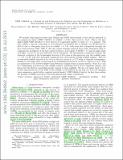| dc.contributor.author | Chornock, Ryan | |
| dc.contributor.author | Berger, Edo | |
| dc.contributor.author | Fox, Derek B. | |
| dc.contributor.author | Lunnan, Ragnhild | |
| dc.contributor.author | Drout, Maria Rebecca | |
| dc.contributor.author | Fong, Wen-fai | |
| dc.contributor.author | Laskar, Tanmoy | |
| dc.contributor.author | Roth, Katherine C. | |
| dc.date.accessioned | 2017-03-01T21:47:09Z | |
| dc.date.issued | 2013 | |
| dc.identifier.citation | Chornock, Ryan, Edo Berger, Derek B. Fox, Ragnhild Lunnan, Maria R. Drout, Wen-fai Fong, Tanmoy Laskar, and Katherine C. Roth. 2013. GRB 130606A as a Probe of the Intergalactic Medium and the Interstellar Medium in a Star-forming Galaxy in the First Gyr After the Big Bang. The Astrophysical Journal 774, no. 1: 26. doi:10.1088/0004-637x/774/1/26. | en_US |
| dc.identifier.issn | 0004-637X | en_US |
| dc.identifier.uri | http://nrs.harvard.edu/urn-3:HUL.InstRepos:30485102 | |
| dc.description.abstract | We present high signal-to-noise ratio Gemini and MMT spectroscopy of the optical afterglow of the gamma-ray burst (GRB) 130606A at redshift z=5.913, discovered by Swift. This is the first high-redshift GRB afterglow to have spectra of comparable quality to those of z ≈ 6 quasars. The data exhibit a smooth continuum at near-infrared wavelengths that is sharply cut off blueward of 8410 ˚A due to absorption from Lyα at redshift z ≈ 5.91, with some flux transmitted through the Lyα forest between 7000−7800 ˚A. We use column densities inferred from metal absorption lines to constrain the metallicity of the host galaxy between a lower limit of [Si/H]&−1.7 and an upper limit of [S/H].−0.5 set by the non-detection of S II absorption. We demonstrate consistency between the dramatic evolution in the transmission fraction of Lyα seen in this spectrum over the redshift range z = 4.9 to 5.85 with that previously measured from observations of high-redshift quasars. There is an extended redshift interval of ∆z=0.12 in the Lyα forest at z=5.77 with no detected transmission, leading to a 3σ upper limit on the mean Lyα transmission fraction of .0.2% (or τ eff GP(Lyα)>6.4). This is comparable to the lowest-redshift Gunn-Peterson troughs found in quasar spectra. Some Lyβ and Lyγ transmission is detected in this redshift window, indicating that it is not completely opaque, and hence that the IGM is nonetheless mostly ionized at these redshifts. We set a 2σ upper limit of 0.11 on the neutral fraction of the IGM at the redshift of the GRB from the lack of a Lyα red damping wing, assuming a model with a constant neutral density. GRB 130606A thus for the first time realizes the promise of GRBs as probes of the first galaxies and cosmic reionization. | en_US |
| dc.description.sponsorship | Astronomy | en_US |
| dc.language.iso | en_US | en_US |
| dc.publisher | IOP Publishing | en_US |
| dc.relation.isversionof | doi:10.1088/0004-637x/774/1/26 | en_US |
| dash.license | OAP | |
| dc.subject | gamma-ray bursts: individual (GRB 130606A) | en_US |
| dc.subject | intergalactic medium | en_US |
| dc.subject | dark ages, reionization, first stars | en_US |
| dc.subject | galaxies: abundances | en_US |
| dc.title | GRB 130606A as a Probe of the Intergalactic Medium and the Interstellar Medium in a Star-forming Galaxy in the First Gyr After the Big Bang | en_US |
| dc.type | Journal Article | en_US |
| dc.description.version | Accepted Manuscript | en_US |
| dc.relation.journal | The Astrophysical Journal | en_US |
| dash.depositing.author | Berger, Edo | |
| dc.date.available | 2017-03-01T21:47:09Z | |
| dc.identifier.doi | 10.1088/0004-637x/774/1/26 | * |
| dash.contributor.affiliated | Chornock, R | |
| dash.contributor.affiliated | Drout, Maria Rebecca | |
| dash.contributor.affiliated | Berger, Edo | |


